

|
Home |
Join Club |
Book Reviews |
Famous Members |
Characters |
Radio |
Genealogy |
Biography |
Harper Lee |
Clippings |
Email Me |
Search |
The New Biography
Biography of Robert Franc Schulkers
Here is the new, professional biography that was published in the Ohio Valley History (Fall 2015) magazine for the University of Cincinnati. Also following are other versions of the RFS bio.
Robert F. Schulkers, Seckatary Hawkins and the Literature of an Ohio Valley Childhood
Gary A. O'Dell and Gregg Bogosian
In the closing scene of Harper Lee's classic 1960 novel, To Kill a Mockingbird, Atticus Finch is seated in the bedroom of his sleeping son, Jem, quietly reading a book from his son's collection. His eight-year-old daughter Scout, the protagonist of the novel, came into the room, sat down next to her father and asked him to read to her from the book, leaning her head against his knee. Atticus turned back to the first page and began to read aloud. H'rm, he said. The Gray Ghost, by Seckatary Hawkins. Chapter One The Gray Ghost, published in 1926, was one of a series of books for juveniles written by Robert Franc Schulkers, a resident of Covington, Kentucky, depicting the adventures of a group of young boys from the point of view of one of the members, Gregory Hawkins. First published in serial form by the Cincinnati Enquirer beginning in 1918, the Hawkins stories proved to be so popular with children that they were soon syndicated to newspapers across the country, and republished in book collections, comic strips, and in live radio broadcasts.1
At the peak of its popularity in the early thirties, children in millions of American households eagerly awaited delivery of the next installment in their local paper. The Seckatary Hawkins Club, established in 1923, by this time had enrolled more than a million members, equal in scale to the contemporary
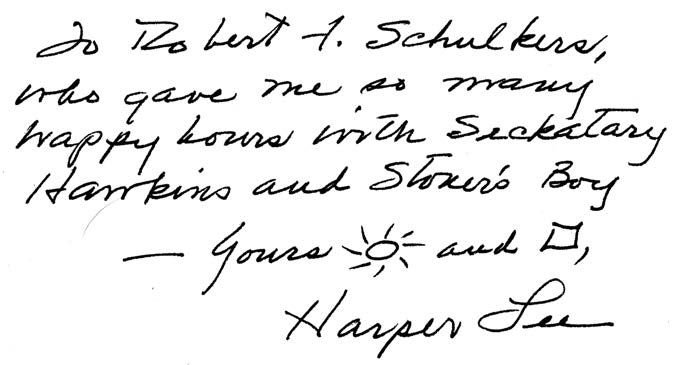
Harper Lee�s inscription on a first edition copy of To Kill a Mockingbird sent to Robert Schulkers.
COURTESY OF CHARLES RANDOLPH SCHULKERS
Mickey Mouse Club and Boy Scouts. While the adults of the nation struggled with the grim reality of the Great Depression, American children like eight-year old Nelle Harper Lee avidly followed the exploits of chubby Gregory Hawkins and his pals as the fictional youths coped with a variety of adventures and mysteries set along the riverfront of a small midwestern town in the late steamboat era. In rural Monroeville, Alabama, young Harper Lee secretly borrowed Seckatary Hawkins books from the collection of her brother Edwin, a member of the club. These books were the favorite stories of Lee and her best friend Truman S. Persons (Capote) and in later life helped inspire her writing about small town life and characters. Her Pulitzer prize-winning novel, To Kill A Mockingbird, contains several references to Seckatary Hawkins stories throughout the text. Lee sent a copy of the first edition of Mockingbird to Schulkers, inscribed, To Robert F. Schulkers, who gave me so many happy hours with Seckatary Hawkins...2
The Hawkins stories debuted during what has often been termed the first "Golden Age" in children's literature, generally considered to span the period from about 1865-1930. During this period many classic tales for young readers were published, including Alice's Adventures in Wonderland (1865), Tom Sawyer (1876), Treasure Island (1883), The Jungle Book (1893), The Wonderful Wizard of Oz (1900), The Story of Dr. Doolittle (1920), and Winnie-the-Pooh (1926). Such stories were written to capture the imagination of children and be entertaining, a marked departure from the moral didacticism that had long permeated literature for children. In the decades before the Civil War, most Americans saw childhood primarily as a time of preparation for adult life, and stories for children were narrowly focused upon teaching morality and rules of conduct. But in the last part of the nineteenth century, juvenile literature became more romantic. According to Anne S. MaCleod, a well-known scholar of the cultural history of children's literature, Fiction for children became warmer, more relaxed, and more amusing when authors ceased trying to improve children and undertook instead to celebrate them. Romantic writers tended to develop a highly sentimental style of writing for and about children, one in which childhood was valued for its own sake rather than simply as a process of becoming adult.3
Much of the literature for children was in the form of serialized stories, relatively short episodes appearing in magazines for juveniles or a series of books comprising a continuing narrative of the life of a young person or group of children. Serials written specifically for youth appeared early in the nineteenth century and by the end of the Civil War there were more than sixty American periodicals devoted to children. By this time a distinct gender separation had developed in juvenile literature. Stories written for boys were suspenseful adventure tales set outside the home. Moral messages that encouraged development of character traits appropriate for manhood were still present, but were now secondary to the story line. Stories for girls, in contrast, were centered on home and family, intense domestic dramas that focused on character and relationships. It was not until the literature of the twentieth century, in the new era of women's rights, that girls became involved in high-spirited adventures outside the home. Little wonder then, that books for boys consistently outsold those published for girls; young female readers were drawn to read boys books to satisfy their own longings for stories of travel and adventure.4
The most significant outlet for fiction for both adults and juvenile readers, from 1860 to World War One, was in newspapers. The growth in numbers and circulation for American newspapers during the latter nineteenth century was truly phenomenal; by 1899, there were nearly 19,000 weekly and daily papers being published and newspapers had become an indispensable part of American life. Most of these papers included syndicated fiction along with news stories and advertisements. According to one scholar, by the dawn of the twentieth century newspaper syndicates had probably exposed a greater number of American readers to more works of fiction than did books and magazines of all kinds.5
The Seckatary Hawkins tales of mystery and adventure were among the most successful and durable of the syndicated serials, offering original stories to young readers in the papers each Sunday for more than twenty-five years between the two world wars. With their sentimental portrayal of childhood as a golden time when children were close to God and nature, and the real business of life was play, these stories capture the essence of developments in juvenile literature that came to fruition in the opening decades of the century. Gregory Hawkins and his companions moved through a richly detailed landscape far removed from the confines of home and adult authority, the local riparian wilderness or the mysterious depths of a cave, engaged in adventures in which they solved mysteries and often coped with dangerous situations and dangerous persons. Yet young readers could draw moral and ethical lessons from these tales; the boys were portrayed as having an inherent goodness and mysteries were solved and problems resolved through the application of courage, honesty, loyalty and common sense. A recurring theme was the development of tension and conflict between opposing groups, represented on the one hand by Hawkins and his small-town friends and, typically, gangs of mean spirited bad boys from the city that invaded their territory.6
The creator of Seckatary Hawkins, Robert F. Schulkers, was born in 1890 in Covington, Kentucky, and grew up in the East side neighborhood just two blocks west of the Licking River. The Licking River waterfront was a dangerous place for a young boy. The banks were steep, and lined with mills, factories and slaughterhouses on both sides. Instead, Robert and his friends explored and played in the green woods along the riverbanks to the south, the area between Covington and Latonia that lay about a mile from home. Robert's early education was provided by the brothers of the Society of Mary at St. Joseph's parochial grade school, located on Twelfth Street near his home.7
As an adolescent, Schulkers often hung around the Covington office of the Commercial Tribune, one of the leading Cincinnati newspapers, fascinated just to watch the branch manager writing up local news. It seemed wonderful to me, he later recalled, to think that I was actually seeing something before it came out in print. I think that I would have done anything to have been allowed to write something that I knew was going to be printed. It would not be long before this cherished ambition was realized. In February 1904 thirteen year old Robert wrote a short story for a contest sponsored by the Tribune for their Sunday children's supplement. The best of the stories were published in three successive issues, and on March 13, young Schulkers first story, His First Capture, appeared in print. In this tale, a young man named Ned Burton is employed as a detective by a small town to track down and put a stop to the flood of counterfeit bills coming into the community.8
The thrill of seeing his name in print must have inspired him to further effort, for in early 1906, the Tribune published three stories in rapid succession in the children's section under his by-line: The Red Feather, The Serpent of Fire, and The Cave of the White Dragon. Although Schulkers was not yet sixteen, he had progressed greatly in the writing craft in the two years since his first story, developing three-dimensional characters and complex story lines and demonstrating a real gift for vernacular dialogue. All three were stories of mystery and adventure,and featured exotic locations.
The content and style of Schulkers stories was very different from the usual bland and moralistic fare offered on the children's pages of the Tribune. The difference is apparent from the titles alone. His Cave of the White Dragon stands in striking contrast to stories such as Nellie's Tea Party or Mischievous Danny Goes to a Picnic, typical of adult freelance writers such as Maud Walker, Helena Davis, and William Wallace, Jr., who were regular contributors of syndicated material for children to metropolitan newspapers during this period. Whereas the majority of juvenile content was obviously intended for very young children, Schulkers, employing themes of life and death, crime and punishment, slavery and freedom, was writing for a more mature audience, stories that could be read and appreciated by adolescents and adults alike.
Robert Schulkers graduated from St. Joseph's High School in 1906 and began his professional career in February 1911, when one of his father's close friends, James Harry Pence, staff librarian at the Cincinnati Enquirer, arranged an introduction to the managing editor, William F. Wiley. Founded in 1841, the Enquirer had become nationally prominent and served as the primary source of news for many residents of the Midwestern region. Impressed with the young man, Wiley offered him a position on the paper as his personal secretary and stenographer.9
Despite these other duties, Schulkers still found time to write children's stories for the Enquirer. His first was a short Christmas tale that appeared on
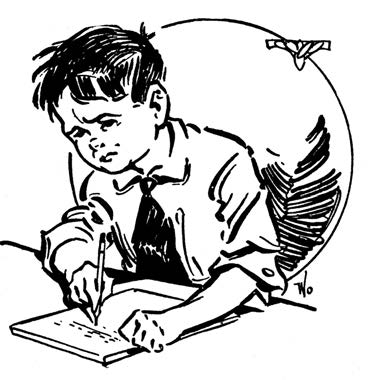
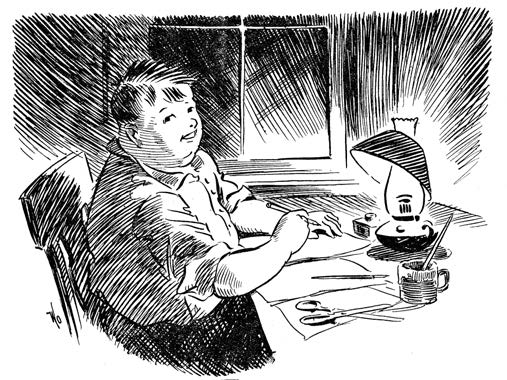
The development of Gregory Seckatary Hawkins as drawn by Carl B. Williams as the series progressed.
Left: From Cincinnati Enquirer, February 17, 1918; Right: From Seckatary Hawkins Magazine, 1924.
COURTESY OF CHARLES RANDOLPH SCHULKERS
December 24, 1911, in the section called Little Corner for Little People. The Little Corner was a regular feature of the Enquirer's Sunday editions and carried a variety of fare intended for pre-adolescents. Schulkers regularly produced stories for the Little Corner; no less than sixteen children's tales appeared under his by-line in 1912 alone. In contrast to his literary creations for the Tribune, whose plots and themes were designed for young people of his own age, the majority of his contributions to the Enquirer were intended to appeal to a younger audience of pre-adolescent readers.10
Early in 1918, Schulkers began thinking about the locations and events of his own childhood. Inspired by these memories, the tale that subsequently appeared in the Enquirer on February 3, Johnny's Snow Fortress, marked the first appearance of Gregory Hawkins. The story portrayed a wintry clash in a long-standing rivalry between two gangs of boys from opposite sides of a river. The story proved to be a big hit with the Enquirer's young readers, and so the Sunday editor, Howard N. Hildreth, asked Robert to write more about Hawkins as a regular weekly feature for the Little Corner. Schulkers had not originally intended for Hawkins and his friends to feature in more than the single Snow Fortress story, so he thought about how to frame the further adventures of these boys. The story had sprung from his own experiences as a child, a time that he remembered as the most glorious boyhood in America! This would be an excellent way to capture the imaginations of his youthful readers; recreate the same setting, populate it with similar characters, and devise magnificent juvenile adventures that captured the glory of those times.11
The wooded west bank of the Licking River, south of Covington, had been a favorite playtime locale for Robert Schulkers and his boyhood pals. One day, he recalled, he suggested to his friends that they should form a club and hold regular meetings every day on the riverbank, an idea that was met with enthusiasm. Along the waterfront nearby was an old sunken houseboat that would make an ideal clubhouse. The father of one of the boys, who owned a team of horses, raised the waterlogged boat from the water and settled it on a sturdy foundation of logs, a safe distance from the water's edge. Once the boat had dried out, the boys were able to hold their meetings like the big men did at their big clubs. At their very first meeting, the boys selected Schulkers to write down the minutes of their doings, and, being very young and a bit uncertain in his spelling, he became the club Seckatary.12
Inspired by these recollections, Schulkers began a chronicle of the further exploits of Hawkins and his friends, the next installment appearing in the Enquirer on February 17, 1918. Although the club was led by an elected Captain, Gregory Hawkins was given the duty of keeping the record of all their plans and activities, and became forever after Seckatary Hawkins and the alter ego of Robert Schulkers. Each weekly Enquirer installment was presented as an extract from the daily activity reports faithfully recorded by Hawkins in a school copybook, each a first-person account written in a simplified youth vernacular and each with an appropriately compelling cliffhanger ending. Schulkers interwove his real experiences as a boy with adventures he wished he might have experienced. With Seckatary Hawkins, he departed from the simple pre-adolescent fare that had, thus far, characterized his literary creations at the Enquirer and, instead, created grittier adventure stories more akin to Robert Louis Stevenson's Treasure Island, in the process appealing to a wider audience of older children as well as adults.13
The locale that Robert Schulkers created for the Seckatary Hawkins stories was a richly detailed landscape loaded with features that made it fascinating for generations of readers. Hawkins and the other boys in the club lived in a small town near a river, and they could escape the mundane world of home and school by a short walk down the river path to their clubhouse, a former houseboat, in the woods on the river bank. The community was based upon Schulkers Covington hometown, and the unnamed river was a composite of the Licking River that forms the eastern boundary of Covington, and the Kentucky River Palisades in the center of Kentucky. The clubhouse was on the western shore, close to the river's edge, in a wooded area corresponding to the area south of Covington that was known as Wallace Woods in Schulkers youth. On the opposite shore was the tiny fictional village of Pelham, most likely modeled after the real-world villageof Wilder, Kentucky, located just across the Licking River.14
Downstream from the Fair and Square clubhouse were several key features, including a wrecked and stranded steamboat and Seven Willows Island. Upstream was the larger town of Watertown (based loosely upon Cincinnati, Ohio), from which descended storm clouds of trouble in the form of various gangs of boys intent on assorted mischief. Most of the Hawkins stories take place close to the river within a few miles of the clubhouse. This landscape was undeveloped, largely devoid of
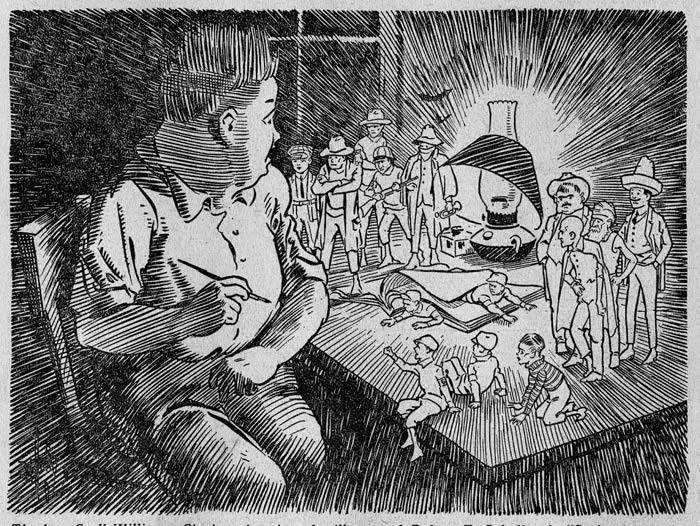
Illustration of Seckatary Hawkins characters springing out of the pages of Gregory
houses, farms, villages or other forms of adult intrusion. Instead, it was a wilderness area of forests and hills and cliffs. The island was a particularly wild and isolated place, covered by a dense green canopy. Hawkins and his club mates had a fleet of canoes, and frequently used the river to move up and down through this forested landscape.
While the Hawkins stories all revolve around plots filled with mystery and danger, the boys also enjoyed the many pleasures of this landscape, gathering and eating blackberries, pawpaws, beechnuts, walnuts, hickory nuts, and chestnuts, hunting and trapping in the woods, and fishing along the river. They often built campfires on the riverbank, and would cook the fish they caught. They had their favorite swimming holes, and would spend a few weeks nearly every summer camping down on Seven Willows Island or in other similarly remote locations. Most winters were cold and snowy, and the boys enjoyed skating on the frozen river and bobsledding on nearby hills. They sometimes rode through the woods on horses borrowed from the farms on which some of the boys lived. All in all it was a tapestry of an enviable life, appreciated not only by Schulkers young audience but also by older readers who led much more complicated lives.
As Hawkins and his friends walked down the wooded river path to their clubhouse after school or first thing on Saturday morning, the stories gave readers the impression that they were stepping across a boundary into a different world, a wilderness of verdant greenery and broadly flowing water, with hillsides pierced by mazes of dark and mysterious caverns. This was a world in which parents and other adults rarely appeared, were seldom even relevant, except in peripheral roles. An occasional steamboat would plow past, paddlewheels churning, often drawing the boys down to the riverbank to watch. In creating the river locale and its historical atmosphere, Schulkers took considerable liberties with American geography. Several story passages indicate that St. Louis was upstream from Watertown and New Orleans was downstream, which corresponds with the course of the Mississippi River. But the fictional river was far narrower than the Mississippi from bank to bank and carried less traffic, and the terrain of the river corridor was, by Schulkers own admission, based on the Licking and Kentucky rivers.
While the clubhouse was the most important locale of the stories, the nearby cliff and cave complex was also significant. On the western shore immediately south of the clubhouse was a high hill surrounded by cliffs. On the side facing the river, these cliffs dropped straight into the water and on the inland sides, there were wooded ravines at the base of the cliffs. A rocky footpath, the cliff path, began a short distance from the clubhouse and proceeded steeply up to the summit. High in the cliffs along this path was the primary entrance to Cliff Cave, a complex with multiple entrances that featured prominently in many stories. Although there are no caves of significance in the vicinity of Cincinnati and northern Kentucky, in the Bluegrass region in central Kentucky, caverns and deep pits are numerous in the limestone cliffs and highlands of the Palisades section of the Kentucky River, a deeply entrenched gorge that extends more than a hundred miles from Frankfort to Boonesborough. Schulkers first became acquainted with this
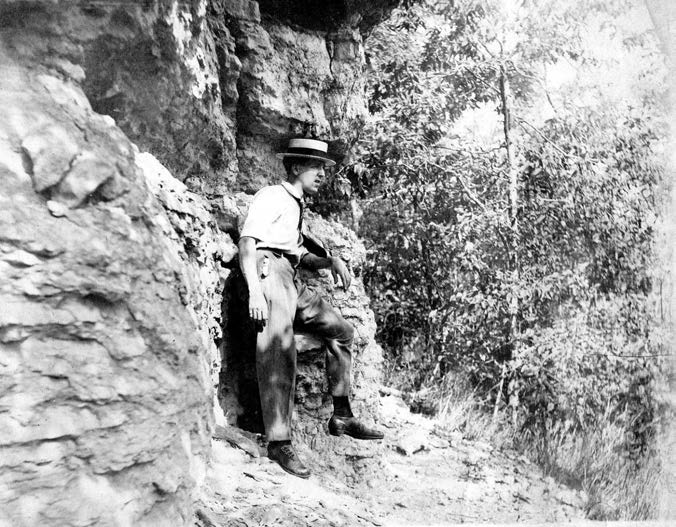
region in 1915, when he married Julia Buckley Darnell. She had grown up in Covington, but her family was originally from Woodford County. Schulkers traveled to the region many times, exploring the local caves and cliffs, and was so fascinated by the limestone caves of Kentucky that most of the Hawkins stories feature a cave as a setting for some of the boys adventures. These were exotic locales for many dramatic action scenes, since many young readers perceived the caves as dark, mysterious, dangerous and scary. Much of the appeal of the Hawkins's books derives from the way Schulkers wove these extraordinary settings into the narrative.15
The Seckatary Hawkins series was a phenomenal success. Illustrated with clean line drawings by Carll B. Williams, director of the Enquirer's art department, the stories resonated with the paper's young readers. Beginning with the February 17, 1918 story, Schulkers delivered an unbroken string of weekly Hawkins story installments that lasted until April 26, 1942, a quarter-century span in which more than 1,200 original adventure tales were published. Schulkers initially found time to produce several additional serials for young readers, including the Boathouse Boys and the popular Mile-a-Minute Milo stories during 1922-1923, but thereafter devoted his entire attention to the adventures of Seckatary Hawkins and friends.16
Most of the Hawkins chronicles consisted of relatively long stories in serial form that ran for half a year or more, occasionally interspersed with shorter tales. Sunday editors at other papers were dismayed by the astounding popularity of the Hawkins stories, and at first attempted to seduce young readers away from the Enquirer by publishing imitations. More and more papers, however, began to inquire about carrying the feature; the Enquirer, which wished to keep Schulkers work exclusive, initially refused these overtures. In August 1923, Robert Schulkers and Julia took a business vacation, visiting thirteen cities in two weeks on a driving tour and selling the series to nine papers. Afterward, he signed with the Metropolitan Newspaper Syndicate to handle the marketing of Seckatary Hawkins, so that by the peak of the Hawkins fad in the late 1920s and early 1930s, the series was carried by more than one hundred newspapers across the country, reaching more than ten million households.17
The series was so popular that the Enquirer was deluged with requests from parents for back issues of the Sunday supplement with Hawkins stories. Since the paper was unable to meet this demand, in midsummer of 1921 editor Wiley suggested that Schulkers compile a book consisting of previously published stories. By this time, nearly two hundred Hawkins episodes had appeared in the paper, but most were relatively short series that did not comprise a cohesive story arc of book length. The ideal candidate was found in Schulkers most recent serial. In autumn of 1920, Schulkers was preparing to take his familyJulia, his wife, and children Robert Jr., and Ruthon an extended vacation to Havana, Cuba, during which he planned to take a break from writing. His editor, however, suggested that he take the character with me and see what exciting adventures he could find in a new environment. Schulkers pounded out the first two chapters at his desk in Cincinnati before departing by passenger liner from Key West, Florida, in November. While in Havana, he wrote six more chapters and completed the remainder of the series upon his return to Ohio. The first installment was published in the Enquirer on November 21 and the final chapter appeared on June 26, 1921. The Cuba story had all the right elements for a compelling mystery tale: an exotic location with a lost pirate hoard and a treasure map. In Schulkers opinion, of all the Hawkins stories to date, this was the best suited as a most interesting book for boys and girls. Seckatary Hawkins in Cuba, published in November 1921 by the Stewart Kidd Company of Cincinnati and illustrated by Williams,
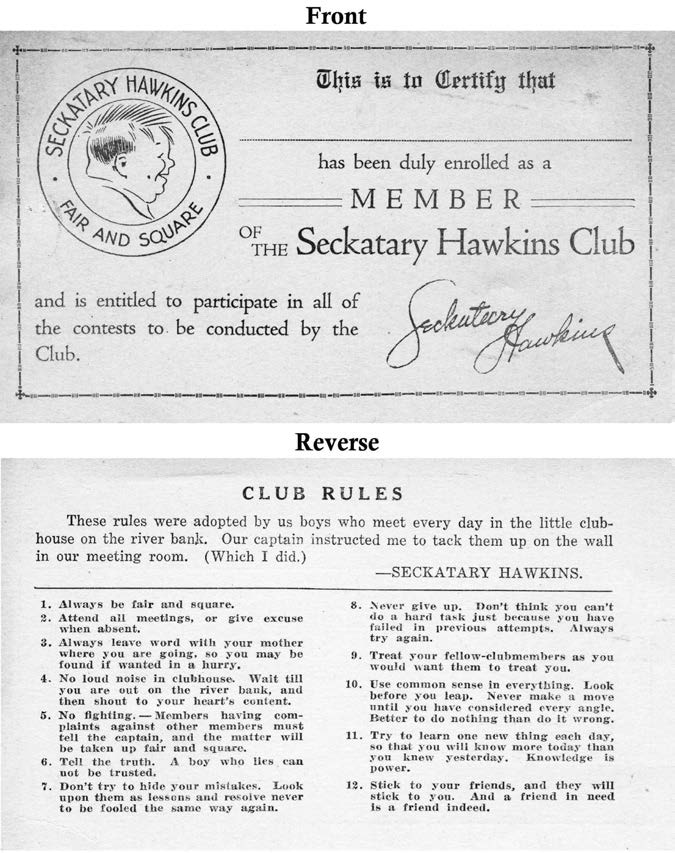
Membership card for the Seckatary Hawkins Club.
COURTESY OF CHARLES RANDOLPH SCHULKERS
was an immediate success, the first of eleven books of collected Hawkins serials published over the next decade under the pseudonym Seckatary Hawkins.18
Readers eagerly anticipated every episode before it appeared in the Sunday papers, the sort of thing one carefully spread out on the floor and studied on hands and knees. For many younger readers, Seck and his friends were all real, not fictional, and so was the clubhouse on the riverbank. Scarcely a day went by in which the Enquirer did not receive a letter from some hopeful child inquiring as to where the clubhouse was located and how they might join the club and share in the adventures. In response to this deluge, in 1923 editor Wiley suggested that the paper create an actual Hawkins club and issue honorary memberships with certificates and badges. Thus the Seckatary Hawkins Club was born in March of that year, an idea which quickly spread to most of the papers in which the Hawkins serials were syndicated. Each child who joined the club was required to sign a pledge that consisted of about a dozen promises and regulations, which, according to Schulkers, were calculated to fortify juvenile idealism and consolidate parental approval. These were later simplified to a single promise to always be fair and square, possessed with strength of character, honest with God and my friends, and in later life a good citizen.19
The response was nearly overwhelming as children across the country rushed to fill out membership applications. By August 1930, the Cincinnati Enquirer alone had enrolled more than 150,000 children; the Pittsburgh Press reported an enrollment of 50,000; and the Milwaukee Journal had nearly 200,000 children on the club roster. Regional newspapers sponsored most of the clubs, with local chapters led by adult volunteers. At the peak of its popularity, the Seckatary Hawkins club boasted more than a million members with branches in all forty-eight states of the Union as well as international chapters in every Canadian province and in South America, Cuba, British West Africa, Ireland, Egypt, Japan, and China. In 1924, nine year-old silent film star Jackie Coogan was so enthralled by the adventures of Seckatary Hawkins that, while on a coast-to-coast charity fundraiser by train, he visited the Cincinnati offices of the Enquirer where Robert Schulkers personally enrolled him into the club and gave him an autographed set of books.20
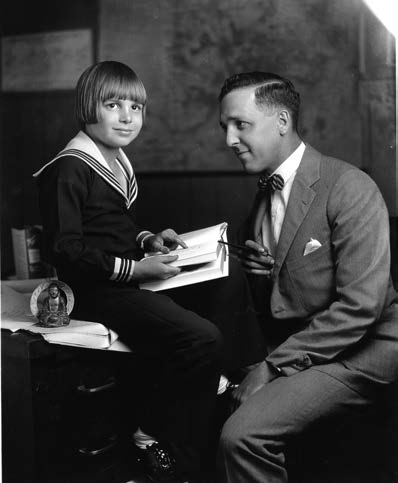
Child actor and Seckatary Hawkins fan
Jackie Coogan with Robert Schulkers
COURTESY OF CHARLES RANDOLPH SCHULKERS
The story of Stoner's Boy was among the most popular tales for many young readers and was Harper Lee's favorite. The serial began in the papers in 1920 and continued with a sequel in 1922, both released in book form in 1926 as Stoner's Boy and The Gray Ghost. Stoner's Boy, whose name is never revealed, was leader of a gang of juvenile criminals from Watertown and was also known as the Gray Ghost since he kept his head covered with a wide-brimmed gray hat and a gray handkerchief over his nose and mouth. Stoner's Boy established a hideout near the clubhouse, inside Cliff Cave, to elude pursuit and capture and in which to store his growing stocks of loot. He stole a large South American bat from a steamboat in Watertown, which was shipping it to a zoo, and planned to release it in the cave to scare away any visitors. This plan went horribly awry when Hawkins and some of his friends chased Stoner's Boy into the cave and shined a bright light upon him. Stoner's Boy has just released the bat, and is tugging at a rope, tied to a peg, which will allow him to swing across a deep chasm and escape. As he worked furiously to release the end of the rope, there suddenly came a great shadow swooping across the ray of light.
What was it? asked Jerry in a terrified whisper.
Good heaven! exclaimed Robby Hood, look at that!
The thing had come back across the light again. It was a bat, the largest
bat I had ever seen. It may have seemed larger in that bright light, but I could
have sworn the wings stretched out as wide as I could stretch out my arms.
We were all frightened.
Get back into the shadow behind the light, ordered Robby.
Just then as we did so Stoner freed the end of the rope and grasped it in
both hands and swung himself across the pit. Just as he reached the middle we
saw the big black thing swoop down from somewhere in the dark above our
heads. It seemed to strike Stoner's face and the wings seemed to close around
his head. We heard Stoner scream oh, he gave an awful scream! The next
second only the rope was hanging there in the bright ray of the lamp.
Good Lord! I shouted, where is he?
Robby was crawling over to the pit. I went down on hands and knees and
crawled beside him. He was peeping down over the edge of the pit.
He fell, whispered Robby to me. Listen.
By that time all of us boys were lying flat on the stoney floor and peeping
over the edge of the pit. But we saw nothing and heard only the rumbling
waters of Cave River as it wound its crooked way through the tunnel of the
cave down, way down, below.
It's the end of Stoner's Boy, said Robby Hood.
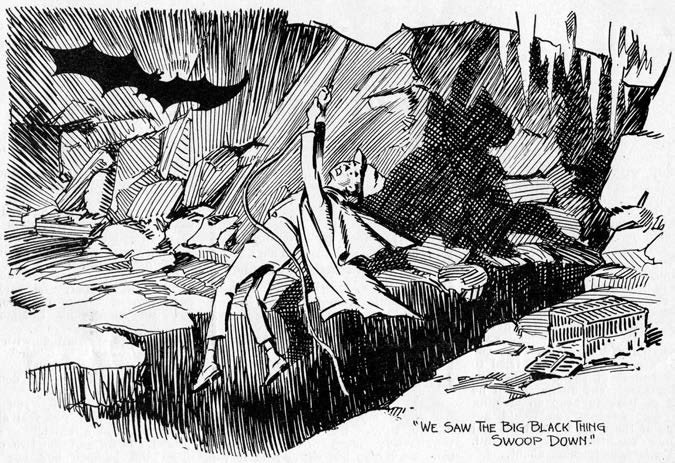
This dramatic incident is considered by many readers as the most memorable moment in all of the Seckatary Hawkins stories, along with the striking illustration of Stoner's Boy swinging across the deep pit just before the bat struck him in the face. Unknown at the time to Hawkins and readers alike, Stoner's Boy survived the fall by landing in the deep waters of an underground river below the shaft. He reappeared in a new serial about sixteen months later, still bent upon mischief, but ultimately repented and went down the river to begin a new life in New Orleans.21
Schulkers was quick to perceive the many potential advantages to be gained by offering Seckatary Hawkins through a variety of media other than the newspaper series and book collections. A monthly periodical, the Seckatary Hawkins Magazine, began initial publication in Cincinnati in 1924, and carried club news, letters from club members, and, of course, a Hawkins serial story. The magazine was prominently displayed at Cincinnati's Provident Bank and leading emporiums such as Pogue's and Shillito's and, each month, hundreds of parents, urged by their frantic kids to please pick up a copy, converged upon the stores. Seckatary Hawkins Magazine was soon offered in other cities where clubs had been organized, and continued publication until 1929.22 Commercial radio broadcasting was also emerging in America at the same time the Hawkins newspaper series was becoming enormously successful. In 1921, there were only a handful of commercial radio stations, and a larger number of amateur broadcasters. One of Cincinnati's first commercial broadcasters was Powel Crosley Jr., who began broadcasting under the call letters WLW in 1922. In June of that year Crosley invited Schulkers to read his Mile-a-Minute Milo stories on the air, thereby becoming the first storyteller to broadcast in Cincinnati.23
In 1923 Seckatary Hawkins came to the airwaves for the first time, debuting as a regular half-hour radio program on Saturday nights. The live broadcasts were scripted by Schulkers, and included reports of Seckatary Hawkins Club activities, contests, recognition of members birthdays, and a Hawkins story narrated by Schulkers. The stories were tied to the series currently being run in the papers, and served to further promote club membership and newspaper circulation. When the growing Crosley media empire acquired Cincinnati's WSAI in 1928, the company gave the Seckatary Hawkins Club a Tuesday evening spot on this station as well. Other papers that ran the syndicated series also began to sponsor their own versions of the show, broadcasting club meetings tailored to local needs.24
The broadcasts were so popular that in 1930 the radio show was given a daily spot in the WLW schedule. Schulkers, who up to this time had simply provided a dramatic reading of the story, now began to act out the parts, providing impersonations of at least seventeen distinct characters, aided at times by his young daughter Judy Schulkers for the female roles. Seckatary Hawkins then became a national radio feature from 1932-1933, sponsored by Ralston Whole Wheat Company and produced by NBC in its studio at the Chicago Merchandise Mart. Broadcast live, the parts were played by a cast of child actors, with Schulkers often providing the voice for adult roles such as that of kindly old Doc Waters. The last of the original Hawkins books, The Ghost of Lake Tapaho, was published in 1932 as part of a radio promotion in which children received a free copy for sending in two Ralston box tops; the Ralston company was delighted by a sales increase of 57% following this promotion scheme.25
The exploding popularity of Seckatary Hawkins in a variety of media prompted Schulkers to resign his position at the Enquirer in May 1926 to devote full attention to his many enterprises. Relations with his former employer remained cordial, however, and the newly established Seckatary Hawkins Service was given office space in the Enquirer building. At about the same time, Schulkers and Cincinnati commercial artist Joe Ebertz came up with a new idea for distribution of the Hawkins series. Ebertz stepped in after the death of Carll Williams in February 1928 to provide artwork for the Sunday stories; for consistency, Joe maintained the graphic style established by Williams in his renditions of story characters.26
Comic strips with sequential panels first began to appear in American newspapers during the late nineteenth century, so-called because the emphasis was upon humor. William Randolph Hearst in his New York Evening Journal introduced the first full page of daily comics in 1912. In the early days of the medium, comics were individual episodes with little or no continuity from the previous day's strip. The fantasy adventures of Little Nemo by Winsor McKay that first appeared in the New York Herald from 1905-1911 signaled the appearance of serial strips. Readers clamored for more and more comics, paving the way for the rendering of the Seckatary Hawkins stories into a comic version.
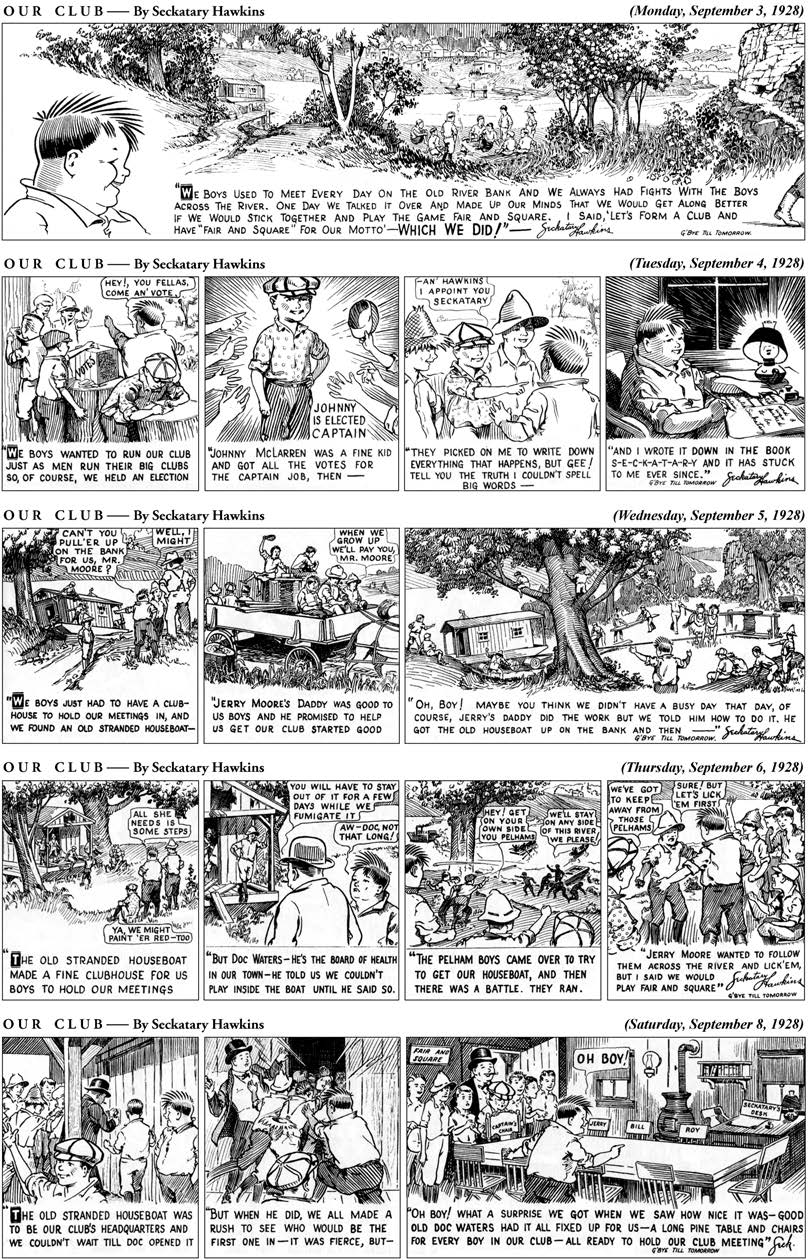
Seckatary Hawkins Comic Strips, Cincinnati Enquirer, September 1928.
COURTESY OF CHARLES RANDOLPH SCHULKERS
The Hawkins comic strip was launched on September 3, 1928, first featuring the stories of 1918-1920 under the title Our Club. Over the next six years, the comic strip replayed, in a new format, stories previously published in narrative form in the Enquirer, so that young readers could not only thrill to new adventures in story form on the Sunday page but, in the comics, catch up on exploits they may have missed. Initially illustrated by Joe Ebertz, the comics appeared every day but Sunday from 1928 to 1934.27
The Seckatary Hawkins club was near and dear to Robert Schulkers heart, and he traveled widely across the country to make guest appearances and help set up new chapters. For club members, he assumed the role of Seckatary Hawkins grown up, a part that was all but indistinguishable from the literal truth. In addition to writing a new story for every Sunday edition, scripts for the radio broadcasts, and working with Ebertz on the daily comic strip, Schulkers also wrote a weekly Letter from the Seckatary that was published on the club page in the Sunday papers. The club page was syndicated to papers in 1926 and appeared on Sundays in association with the serial stories, and featured regular weekly contests and letters from members. Some papers devoted considerable space, two to four full pages, to the Hawkins club. Many papers also began to run a daily club section that was personalized to suit the interests of local branches. Clubs sponsored parties and picnics and field trips to the movies and ball games, often attended by thousands of eager club members; at one such event, a 1932 Saturday picnic at Waukesha Beach in Wisconsin, more than 24,000 children showed up for the festivities.28
As Robert Schulkers was one person and the club was nationwide, the adult personification of Seck known to club members of a particular region was often assumed by a local man adept at working with young children, usually a member of the sponsoring newspaper's staff. To club members, the original Seck, Robert Schulkers, was a distant, all-but-invisible figure whose rare appearances were attended with the pomp and ceremony that might be accorded to a visiting dignitary. Among the largest clubs in the nation were those sponsored by the Pittsburgh Press and the Milwaukee Journal. Seckatary Hawkins was relatively late in making an appearance in Pittsburgh, but in October 1930 the Press announced the arrival of the chubby little fellow in comic strip form with great fanfare. Soon after, at the formative meeting of the Seckatary Hawkins Club sponsored by the Press, more than 2,000 children enrolled as charter members. By the first anniversary of the club, membership had grown to more than 50,000. Harry C. Milholland, president of the newspaper and known as Daddy Milholland to the children of the club, was an ardent supporter and often wrote items for the club news. Milholland recruited Edwin J. Ritenbaugh, an employee with a vaudeville background, to take charge of the club. For more than 25 years, Ed played the stand-in role of Seck for club members and witnessed the phenomenal
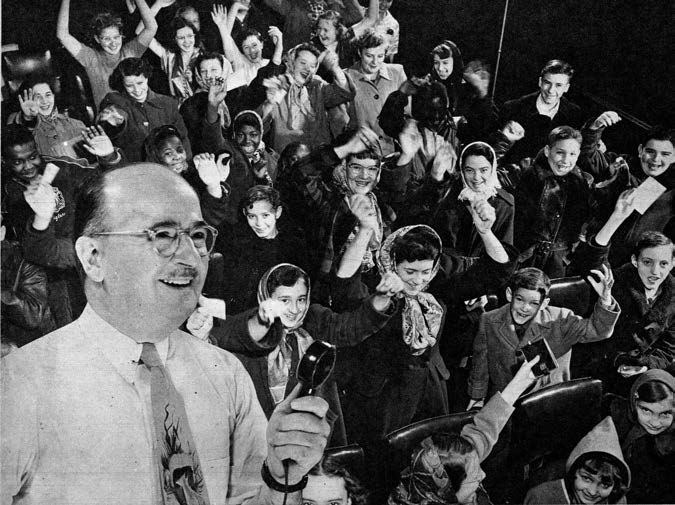
Ed Rittenbaugh, the local stand-in for the popular Pittsburgh branch of the Seckatary
Hawkins Club in western Pennsylvania. From Pittsburgh Press, December 24, 1950.
COURTESY OF THE AUTHORS
growth of the club to include, by 1955, more than 125,000 active members in the three state area (western Pennsylvania, West Virginia, and eastern Ohio) with an alumni enrollment of nearly 500,000. Ritenbaugh was so successful in adopting the Seckatary Hawkins persona that, by the end of the 1930s, the identity of the original, Robert Schulkers, was all but unknown in the region.29
In Milwaukee, Hawkins stories first began to appear in the pages of the Journal's new Boys and Girls Magazine supplement in September 1925. Club pages were added to the Sunday stories in September 1926, and expanded to daily club news in 1929. The Journal began operating its newly licensed radio station, WTMJ, in 1927, with Saturday afternoon broadcasts of the Seckatary Hawkins Club. The debut of the syndicated Hawkins comic strip in 1928 prompted a simultaneous expansion of the radio program to a daily slot. The Journal's industrious promotion of the club through multiple media so boosted enrollment that by 1932 the Wisconsin club had become the largest in the nation with more than 200,000 members. The role of Seck was taken by Lawrence E. Teich, a staff writer for the Journal and announcer with WTMJ who had been broadcasting the Milwaukee version of the Hawkins radio show from its inception. Teich launched himself into the part as a full-time occupation, and to the children of the Wisconsin club, he was the real Seck, a genial man who had no other name but was the person they heard daily on the radio and who organized and appeared at all the club outings.30
On July 12, 1929, Larry Teich announced in the Journal's Club News that soon would commence one of the greatest undertakings that any club has ever had the Seck Hawkins Club is going to make a regular two-reel movie that will be shown in big Milwaukee theaters. The movie, which had a baseball theme and was called Homerun Hawkins, was a two-reel silent film made with sponsorship from Fox Theaters and using a professional director and cameramen. The cast was chosen from boys and girls among the membership. Homerun Hawkins premiered in Milwaukee on August 15, the first appearance of Seckatary Hawkins and friends in an exciting new medium. The success of the film led the Enquirer to announce in October 1930 that, in collaboration with RKO Theaters, the paper was going to sponsor a Cincinnati remake of Homerun Hawkins with the same script but a different cast and crew. Eager boys and girls flocked to Cincinnati's Palace Theater to audition and were thrilled to meet comic strip illustrator Joe Ebertz, who was responsible for selecting a handful of candidates from whom the role of Seckatary Hawkins would be chosen. As a special treat, Ebertz drew pictures of characters from the strip and handed them out to the young fans.31
The cast of the film included Robert Schulkers as Doc Waters and his fourteenyear- old son, Robert, Jr. as Hawkins close confidant Shadow Loomis, as well as Cincinnati city manager Clarence A. Dykstra, who, along with several other prominent residents, volunteered to play one of the grown-up parts. Veteran Clarence E. Runey, proprietor of the Cincinnati Motion Picture Company, supervised filming, and city locations included both the Kemper log cabin at the Cincinnati Zoo, as stand-in for the clubhouse, and Redland Field, home of the Cincinnati Reds. The film premiered at the Palace Theater a month later, and was then shown in surrounding counties and a copy was sent to the Pittsburgh Press for showing in theaters of that city. Not to be outdone, the Milwaukee club made a second film, Seckatary Hawkins, Detective, in summer 1931.32
Despite having professional assistance, all three movies were strictly low-budget amateur efforts, and neither Fox nor RKO picked any of them for national distribution; screenings remained confined to the states in which they were produced. Correspondence shows that Schulkers was investigating whether a major studio, such as Fox Films, Hal Roach, or Tri-State, would be interested in producing a series of films based upon his Hawkins stories, but nothing seems to have germinated from his inquiries beyond the amateur productions in Wisconsin and Ohio. Schulkers does not appear to have made any determined effort to break into the medium of film; his primary motivation in supporting the three movies seems to have been to provide an activity for club members that was fun and exciting. Although Schulkers was an astute promoter and achieved a modest wealth from book and syndication royalties, he made no attempt to commodify Seckatary Hawkins in terms of marketable merchandise. A few items were produced in limited quantities, such as iconic Hawkins statues and bookends, but
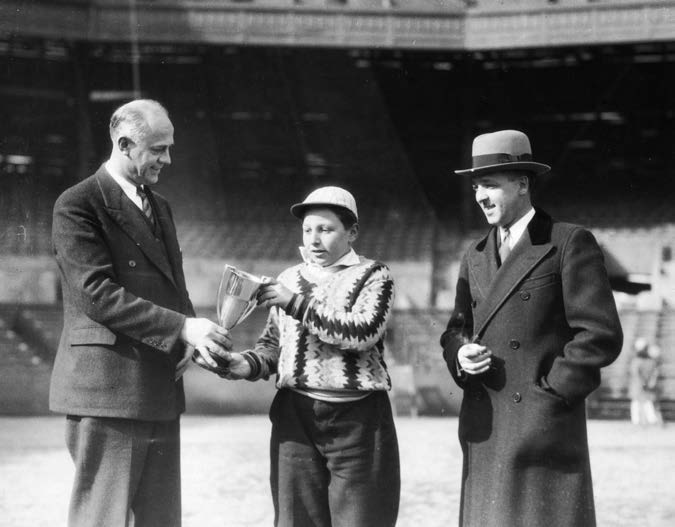
Publicity shot from Home-Run Hawkins taken at Redlands Field. Cincinnati City Manager
Clarence Dykstra presents a trophy to Herbert Cohen, the boy who was chosen to play the
role of Seckatary Hawkins in the film, as Robert Schulkers looks on.
COURTESY OF CHARLES RANDOLPH SCHULKERS
these, as well as copies of Schulkers books, were given away as contest prizes rather than sold. In this regard, Schulkers business practice stands in contrast to that of one of his contemporaries, Walt Disney, whose original Mickey Mouse Club competed with Seckatary Hawkins for the attention and allegiance of preadolescent children.33
The Seckatary Hawkins phenomenon peaked in the early 1930s, but began a precipitous decline about 1932-1933, the height of the Great Depression, when many newspapers canceled the comic strip and story series. When asked, Schulkers attributed the loss of newspaper outlets to a shortage of newsprint during the Depression. This is unlikely; paper was in short supply during the following decade due to wartime rationing, but was readily available in the 1930s. A more likely cause for attrition of Seckatary Hawkins outlets was as a side effect of what was known as the Newspaper-Radio War. Schulkers, in fact, alluded to the circumstances in explaining why he failed to renew his contract with Ralston, sponsor of the NBC broadcasts of the Seckatary Hawkins national radio show:
As soon as I went on as a commercial, many of my good newspaper clients discontinued [Seckatary Hawkins], because in that year (1932) there was a decided antagonism between the papers and the radio stations on account of the advertising angle. Since my newspaper revenue was so much larger than the radio, I turned down the latter.34
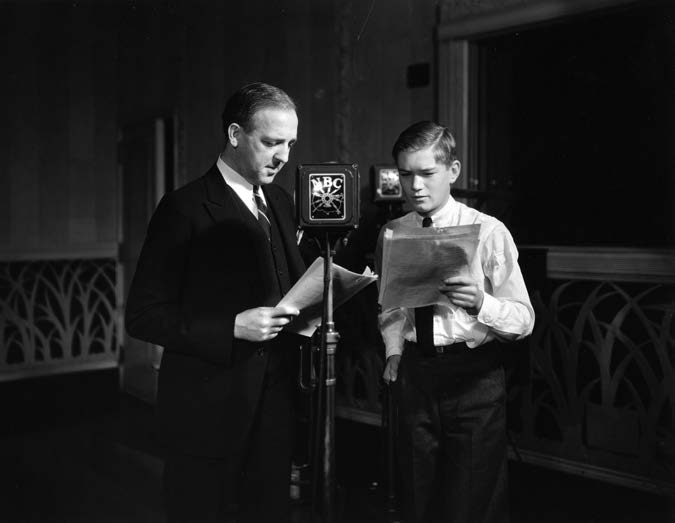
Robert Schulkers and Murray McClean, who voiced Seckatary Hawkins, in publicity still for
the Seckatary Hawkins Club radio show that aired nationally on NBC from 1932-33.
COURTESY OF CHARLES RANDOLPH SCHULKERS
This war had its origins in news broadcasting. Prior to 1930, radio news was provided by once-a-week commentaries, with occasional short bulletins for news of high interest. In the fall of 1930, NBC began airing regular evening newscasts and other networks soon followed suit. These stations did not actually compile their own news, but just repackaged copy from the various wire services, which were controlled by the newspaper industry. Radio's incursions into news reporting worried publishers, who already felt squeezed by the depression, and declining advertising revenues, so they pressured the wire services into cutting off each station's access to the news. Radio networks were bullied into signing a restrictive agreement in December 1933, the terms of which greatly limited the ability of radio stations to provide news. Within a year, however, commercial wire services were again selling news to radio and fewer and fewer stations were abiding by the restrictions. The effort to curtail radio news broadcasting was effectively dead, and by the end of the thirties, the structure of journalism had changed forever. The Seckatary Hawkins show began to air nationally in 1932, precisely when the press-radio war was peaking, and widespread cancellation of the Hawkins comic strip was most likely a retaliatory response by publishers to the perceived threat of radio. The last Hawkins comic appeared in the newspapers on May 26, 1934.35
In October of that year, the Cincinnati Enquirer severed a seventeen-year relationship when it decided to stop carrying the Seckatary Hawkins stories in any format, print or graphic, a remarkable turn of events considering that the paper was the original home of the series. Only a few years before, in 1928, the paper's circulation manager had written a letter of appreciation to Schulkers in which he stated that a recent survey of 57 towns had shown the Seckatary Hawkins feature to be the Enquirer's best builder and holder of Sunday circulation. Schulkers did not provide an explanation for the Enquirer's action, but it was most likely attributable to the hostility of the print media against radio incursions that led many other papers to cancel the series. Schulkers thereafter switched to the Cincinnati Post in December 1934 for hometown publication of his stories.36
Although by the end of the 1930s there remained only a handful of newspapers in which Seckatary Hawkins still appeared, Schulkers continued to write new stories as long as there were papers willing to publish them. At last, in April 1942, he said good-bye to the beloved characters of his imagination and closed the clubhouse door behind him after completing The Gang of Usher, a 38-episode Hawkins serial. The last original Seckatary Hawkins episode was published on April 26, 1942, although reprints of earlier stories continued to be published in dwindling numbers of newspapers until 1951. Yet the door was left open, just a crack, because thirty years later, at the time of his death, Schulkers was working on a new Hawkins tale that, according to his grandson Randy, would bring Gregory Hawkins into the modern world as a young adult. Kids of today are just as romantic and adventuresome as were their fathers and grandfathers who were fans of Seckatary Hawkins, Robert said in 1966. But their lives have been changed by radio and TV from the time of the adventures Seck wrote about in his diaries. On April 6, 1972, Robert Franc Schulkers died from a sudden heart attack at his home on Erie Avenue in Hyde Park, Cincinnati.37
For more than two decades, the adventures of Gregory Hawkins and his friends entertained American children. These tales celebrated an idealized version of boyhood, close to nature and free from the confines of home. Adult authority was acknowledged but distant; the youthful characters made their own decisions and their actions were guided by an inherent morality and adherence to masculine virtues to overcome obstacles and resolve conflicts. The Seckatary Hawkins tales of mystery and adventure represented a relative rarity in children's literature, receiving both peer group and parental approval. Younger readers had no doubts that the fictional characters were real persons and the events depicted really happened, duly recorded by the Seckatary and forwarded to the offices of the Cincinnati Enquirer. To the children of Cincinnati in particular, Gregory Hawkins and his friends were local boys, not so different from themselves, who were able to lead enviable lives pursuing boyhood pleasures and thrills. Although Schulkers core audience was centered in the Midwestern region, his stories were so universally appealing that juvenile readership spanned the nation and even extended abroad. For the Enquirer and other participating newspapers, the syndicated stories were proven circulation boosters and so were heavily promoted, by associated comic strips and radio broadcasts and, most effectively, through the establishment of local Seckatary Hawkins clubs.
Simultaneous with the Hawkins stories, serialized juvenile fiction peaked in the 1920s and 30s with the productions of the Stratemeyer syndicate's fiction factory, which sold millions of books in such immensely popular adventure series as Tom Swift, the Hardy Boys, and Nancy Drew. In contrast, the primary outlet for the Hawkins stories was through the newspapers, and although sales of collected Hawkins stories in book form did not even begin to approach the volume of Stratemeyer titles, the wide circulation of the newspapers assured a nearly equivalent readership. By any measure, the stories crafted by Robert Schulkers can be considered as among the most successful developments in twentieth-century American fiction for young readers.38
|
The authors would like to express their appreciation to Charles R. Schulkers and the modern-day Seckatary Hawkins Club for graciously sharing many original Schulkers documents and for insightful and helpful comments during the writing process. 1 Harper Lee, To Kill A Mockingbird (Philadelphia and New York: J. B. Lippincott Co., 1960), 294-295. 2 Andrew Haggerty, Harper Lee: To Kill a Mockingbird (Tarrytown, NY : Marshall Cavendish Benchmark, 2010), 19-21; Personal communication from Charles R. Schulkers, 2013; Copy of To Kill a Mockingbird, (1st ed.). Several unauthorized biographies of Lee, notably Charles J. Shields in Mockingbird: A Portrait of Harper Lee (New York: Henry Holt, 2006), 46 and Haggerty, Harper Lee, have claimed that she joined the Seckatary Hawkins Club as a child. This is an error; although young Harper avidly read the Hawkins books, it was not until 1998 that she joined the modern-day club, still a fan at age 72 (Charles R. Schulkers, personal communication with the author, 2015). 3 Anne S. MacLeod, American Childhood: Essays onChildren's Literature of the Nineteenth and TwentiethCenturies (Athens and London: University of GeorgiaPress, 1994, 72, 13-14, 23-24, 74, 89-90, 144-156; Sheila A. Egoff, Thursday's Child: Trends and Patterns in Contemporary Children's Literature (Chicago: American Library Association, 1981), 4-7. 4 Faye R. Kensinger, Children of the Series and How They Grew, or, A Century of Heroines and Heroes, Romantic, Comic, Moral (Bowling Green, OH: Bowling Green State University Press, 1987), 3-17; Carol Billman, The Secret of the Stratemeyer Syndicate: Nancy Drew, the Hardy Boys, and the Million Dollar Fiction Factory (New York: Ungar Publishing, 1986), 6-8; MacLeod, American Childhood, 14, 164-165; Gail S. Murray, American Children's Literature and the Construction of Childhood (New York: Twayne Publishers, 1998), 54-62, 67, 84-94, 97. 5 Charles Johanningsmeier, Fiction and the American Literary Marketplace: The Role of Newspaper Syndicates, 1860-1900 (Cambridge, UK: Cambridge University Press, 1997), 1-12. 6 MacLeod, American Childhood, 117. 7 Charles R. Schulkers, Robert Franc Schulkers Biography (2000), http://www.seckatary.com/, accessed Sept. 27, 2010; James T. Golden, Jr., Seckatary Hawkins Still Rings Bell With Children, Cincinnati Enquirer (hereafter Enquirer), June 19, 1949; Bob Recalls Heyday of Seck Hawkins, Enquirer, Jan. 30, 1966. The street address of Schulkers childhood home, which is still standing, is today 220 East Thirteenth Street. 8 Robert F. Schulkers (hereafter RFS), untitled typescript (1936), Schulkers Papers. The Schulkers Papers are a loosely organized collection of documents and papers curated by the author's grandson, Charles R. Schulkers, in Powhatan, Virginia. 9 Graydon DeCamp, The Grand Old Lady of Vine Street: A History of the Cincinnati Enquirer (Cincinnati, 1991); RFS, resume dated Sept. 1918, Schulkers Papers. The Tribune was absorbed by the Cincinnati Enquirer in 1930, which is today the only surviving daily print newspaper serving Cincinnati and northern Kentucky. 10 RFS, autobiographical notes, 1926, Schulkers Papers. The number of stories that were written by Schulkers prior to the Hawkins series has been difficult to ascertain. 11 RFS, Johnny's Snow Fortress, Enquirer, Feb. 3, 1918; reprinted in Seckatary Hawkins Stories From 1918 (Richmond, VA, 2011), 13-20; RFS, untitled typescript (1936), Schulkers Papers; Seckatary Hawkins, typescript, n.d. (ca. 1930), Schulkers Papers; RFS, The Story of Seckatary Hawkins, n.d., Schulkers Papers; Life's Detour is Completed by Columnist for Enquirer, Enquirer, June 7, 1936. 12 RFS, Seckatary Hawkins, typescript, n.d. (ca. 1930), Schulkers Papers. 13 Many adult readers found Schulkers realistic rendition of preadolescent grammatical mangling and misspellings rather startling. After Cincinnati Public School's Superintendent Randall J. Condon complained that his children were starting to talk and write like Seckatary Hawkins, Schulkers improved the grammatical quality of Gregory Hawkins copybook compositions. See Bob Recalls Heyday of Seck Hawkins. 14 Although in his papers Robert Schulkers identified the fictional home town of the boys as based upon Covington and Watertown upon Cincinnati, he did not make specific note of the corresponding equivalent for Pelham. Many readers have assumed that Newport, Kentucky, was the model for Pelham, since Newport was located directly across from Covington and has long had a reputation as a center of criminal activity (see Thomas Baker, Gary W.Potter, and Jenna Meglen, Wicked Newport: Kentucky's Sin City, Charleston, SC, 2008). There is, however, rather compelling circumstantial evidence pointing to Wilder, Kentucky, as the model for Pelham. Pelham is described in the stories as a small rural town with the Pelham hills rising beyond, whereas Newport was a fully developed urban area even in the early twentieth century. The modern suburban community of Wilder is located directly across the Licking River from Wallace Woods, where Schulkers played as a child, and in the early 1900s was a rural village set at the foot of some steep hills. There are also some more specific indicators. In the Seckatary Hawkins stories, mention is made of both a St. John's church and a steel mill being located in Pelham. A church of that name is present in Wilder, and during the early part of the century a steel mill was in operation in the area across from Wallace Woods. 15 Voice Over Phone Revealed Romance, Kentucky Times- Star, Feb. 12, 1915; Charles R. Schulkers, personal communication, 2013; RFS, The Faithful and Unpretending Record of an Interesting Trip to Germany Down in Old Kentucky, in the County of Woodford, Sept. 6, 1915, photo scrapbook and typescript, Schulkers Papers. Gary A. O Dell and Gregg Bogosian, Seckatary Hawkins and Cliff(ton) Cave: the Subterranean Adventures of Robert F. Schulkers, NSS News (National Speleological Society 72 (July 2014), 10-20. 16 Artist's Brush is Laid Aside: Carll Williams Called by Death, Enquirer, Feb. 11, 1928; RFS, The Story ofSeckatary Hawkins, n.d., Schulkers Papers. Caroline Williams (1908-1988), Carll's daughter, was a well known artist celebrated for her depictions of Cincinnati and northern Kentucky; see Marion Glaser, She Loves Our Valley: Caroline Williams, Queen City Artist, Cincinnati (Feb. 1973), 7-10. The original Seckatary Hawkins newspaper episodes were published on Sundays from Feb. 3, 1918 to April 26, 1942, constituting 1,264 episodes. Of these, 47 were reprints of earlier stories, yielding the figure of 1217 original episodes published during the time span. After April 26, 1942, only reprints of earlier episodes were published, in ever-dwindling numbers of newspapers, until the run came to a final end on Nov. 25, 1951. 17 RFS, Seckatary Hawkins, typescript, n.d. (c.a. 1930), Schulkers Papers; Golden, Hawkins Still Rings Bell 18 Golden, Hawkins Still Rings Bell; RFS, passport application, Oct. 20, 1920, U.S. Passport Applications 1795-1925, Roll 1396, Certificate 101868; Kay Hamilton, interview with Robert F. Schulkers, WSAI Cincinnati, May 25, 1949, audio tape, Schulkers Papers; Foreword to first edition of Seckatary Hawkins in Cuba (Cincinnati, 1921). The eleven books released by Robert Schulkers during his lifetime are Seckatary Hawkins in Cuba (1921), The Red Runners (1922), Stormie the Dog Stealer (1925), Stoner's Boy (1926), The Gray Ghost (1926), Knights of the Square Table (1926), Ching Toy (1926), The Chinese Coin (1926), The Yellow Y (1926), Herman the Fiddler (1930), and The Ghost of Lake Tapaho (1932). Beginning in 2007, Robert Schulkers grandson, Charles R. Schulkers, began collecting and editing the remaining stories into new books, and restoring missing chapters omitted from the original books during the editing process. Today there are a total of 32 books in the series, including two volumes containing a complete set of the Seckatary Hawkins comic strips that appeared in syndicated papers from 1928 until 1934. Book titles and descriptions can be viewed on the webpage of the modern Seckatary Hawkins Club, www.seckatary.com. |
19 Judy Findsen, A Kid Pleaser Fair and Square, Enquirer Magazine, Sept. 29, 1974; RFS, Seckatary Hawkins, typescript, n.d. (c.a. 1930), Schulkers Papers; Golden, �Hawkins Still Rings Bell. The Schulkers quotation is from an interview reported in Green (1966). 20 RFS, chronological notes 1918-1938, Schulkers Papers; RFS, untitled typescript (1936), Schulkers Papers; RFS, Seckatary Hawkins, typescript, n.d. (c.a. 1930), Schulkers Papers; Seck Hawkins Boys, Girls Celebrate Club Birthday, Pittsburgh Press, Oct. 26, 1931; Manitowoc Herald-Times, Nov. 14, 1930; Jackie Coogan Day is Here, Enquirer, Aug. 9, 1924; Jackie Coogan Makes Charity Appeal: Joins �Seckatary Hawkins Club, Enquirer, Aug. 10, 1924; Jackie Coogan is perhaps better known to modern readers for having played the role of Uncle Fester in the 1964-1966 television sitcom, The Addams Family. Other youngsters who joined the club and later achieved modest fame as adults include television host Durward Kirby (1911-2000) and the multitalented singer, dancer and actor Gene Kelly (1912-1996). 21 Enquirer, Oct. 10, 1920; RFS, Stoner's Boy, The Gray Ghost (Cincinnati: Seckatary Hawkins Co., 1926). 22 Findsen, Kid Pleaser; RFS, chronological notes 1918- 1938, Schulkers Papers. 23 Rusty McClure, David Stern, and Michael A. Banks, Crosley: Two Brothers and a Business Empire That Transformed a Nation (Cincinnati, 2006), 128-131, 136- 140; John Kiesewetter, WLW 700 Turns 80, Enquirer, March 17, 2002; RFS, chronological notes 1918-1938, Schulkers Papers; Transcript of radio interview with Robert F. Schulkers, WSAI, n.d., Schulkers Papers. 24 McClure, et. al., Crosley, 128-136; On Air Decade: WLW Feature is Still a Favorite, Crosley Radio Weekly (Sept. 6, 1931, 1; Golden, Hawkins Still Rings Bell; Buys WSAI, Playing Card Station, for $100,000, Enquirer, May 8, 1928; RFS, chronological notes 1918- 1938, Schulkers Papers. 25 Answers to Questions, Cleveland Plain Dealer, April 23, 1924; RFS, chronological notes 1918-1938, Schulkers Papers. A second Ralston radio premium book was planned, Mystery of the Stonewall House, and a typed manuscript prepared, but the book was not issued. It was at last published in 2007 by the author's grandson, Charles R. Schulkers. 26 Golden, Hawkins Still Rings Bell; Green, Bob Recalls Heyday; Findley, Kid Pleaser; Artist's Brush is Laid Aside: Carll Williams Called by Death, Enquirer, Feb. 11, 1928; Joseph Ebertz, Illustrator, Enquirer, Sept. 1, 1968. Ebertz took over from Carll Williams as illustrator of the Sunday newspaper stories beginning on March 4, 1928 and continued until the Sunday story of Nov. 5, 1933. He returned as illustrator of the Sunday stories starting on March 21, 1937 and contributed his final drawing for the Sunday story of June 2, 1940. 27 Graflix Multimedia, The History of Comics, http:// www.comic-art.com/, accessed Oct. 2013; Pierre Couperie and Maurice C. Horn, A History of the Comic Strip, trans. Eileen B. Hennessy (New York,1968), 19-53; RFS, chronological notes 1918-1938, Schulkers Papers. Joe Ebertz provided illustrations for the comics until Oct. 30, 1933, when he was replaced by Victor Erwin. Ebertz returned as illustrator of the Sunday stories from March 21, 1937 to June 2, 1940. 28 Seck's Picnic: What a Time! Milwaukee Journal, June 19, 1932. 29 Pittsburgh Press, Oct. 13-20, 1930; Seck Hawkins Throws a Party, Pittsburgh Press, March 8, 1931; Seck Hawkins, Pittsburgh Press, Dec. 24, 1950; Ray Hoffman, Seck and His 500,000 Good Citizens, Pittsburgh Press, March 4, 1956
30 WTMJ Ten Years Old, Milwaukee Journal, July 25, 1937; Radio program schedules, Milwaukee Journal, July 30, 1927, Sept. 4 1928; Larry Teich, First Announcer, Head of Oldest Program, Milwaukee Journal, July 24, 1932; Our Club's All-Stars Planning Reunion to Rehash Old Times, Milwaukee Journal, Feb. 23, 1965; Branch Club News, Milwaukee Journal, June 9, 1929. 31 Seckatary Hawkins Club News, Milwaukee Journal, July 12, 15, 22, 27, 1929; Contract, July 10, 1929, Schulkers Papers; Homerun Hawkins Opens Friday at the Wisconsin Theater, Milwaukee Journal, Aug. 15, 1929; Theater advertisement, Milwaukee Journal, Aug. 16, 1929; Your Chance, Enquirer, Oct. 12, 1930; Yea, Skinny! Enquirer, Oct. 14, 1930; Pst, Boys, Enquirer, Oct. 18, 1930. 32 Hawkins Club Borrows City's Boss, Enquirer, Oct. 20, 1930; These Boys to Take Part in Seckatary Hawkins's Movie, Enquirer, Oct. 21, 1930; In Role of Seckatary, Enquirer, Oct. 22, 1930; To Be in Home Run Hawkins Movie, Enquirer, Oct. 23, 1930; May Be Skinny Guy Enquirer, Oct. 24, 1930; Seck'ty Hawkins Appears in Film With Local Boys, Enquirer, Nov. 2, 1930; One Will Be Home Run Hawkins Hero, Enquirer, Oct. 18, 1930; Hawkins Film Is Nearing Completion, Enquirer, Nov. 6, 1930; Seckatary Hawkins Film Ready, Enquirer, Nov. 21, 1930; Movie advertisement for RKO Palace Theater, Enquirer, Nov. 22, 1930; Death of C.E. Runey, Printers Ink 154 (Jan. 1, 1931), 114; Billboard 56 (Dec. 23, 1944), 22; RFS, chronological notes 1918-1938, Schulkers Papers; Club News, Milwaukee Journal, Feb. 1, April 12, 23, 25, 30, May 3, Aug. 16, Oct. 7, Nov. 4, 20, Dec. 19; Extra! Seck Hawkins, Detective, Makes Its First Milwaukee Appearance, Journal, Dec. 20, 1931. Homerun Hawkins was Runey's last film; he died at the age of 63 on Dec. 20, 1930, less than a month after the premier of the film. 33 E[lsie] A. Gentsch, Romell Motion Pictures, Inc., to RFS, Nov. 2, 1926; Gilbert P. Hamilton, Tri-State Motion Picture Co. to RFS, June 11, 1928; unknown to William K. Howard, Fox Film Corporation, Dec. 23, 1931; Kenneth R. Porter, Hal Roach Studios, to RFS, Jan. 5, 1932, all from Schulkers Papers. If Hal Roach had not already been involved in producing a highly successful series of comedy shorts with child actors, he might have been more open to Schulkers proposal, and the public might have been treated to an entirely different version of Our Gang. The first short, silent one-reel Little Rascals film was made by Roach in 1922, with talkies introduced in 1929. 34 Brookings Institution, America's Capacity to Produce, 5th ed. (Menasha, WI, 1938), 238-246; Alfred M. Lee, The Daily Newspaper in America: The Evolution of a Social Instrument (New York, 1937), 104-105; RFS to Bill, n.d., Schulkers Papers; Golden, Hawkins Still Rings Bell; Green, Bob Recalls Heyday; Findley, Kid Pleaser. During World War Two, the U.S. War Production Board Order L-240 implemented newsprint rationing from 1943-1945. 35 Christopher H. Sterling and John M. Kitross, Stay Tuned: A History of American Broadcasting, 3rd ed. (Mahwah, NJ, 2002), 135-137, 193-194; Robert W. McChesney, Telecommunications, Mass Media, and Democracy: The Battle for the Control of U.S. Broadcasting, 1928-1935 (New York, 1993), 163-177; Edwin Emery and Michael Emery, The Press and America: An Interpretive History of the Mass Media, 5th ed. (Englewood Cliffs, NJ, 1984), 447-448. 36 Harry C. Kloecker to RFS, June 5, 1928, Schulkers Papers; RFS, chronological notes 1911-1963, 1918-1938, Schulkers Papers; Cincinnati Post, Dec. 7,8, 1934. 37 Schulkers, Schulkers Biography. The Gang of Usher ran from Aug. 1941 to April 1942 and was first published in limited edition book form by his grandson, Charles R. Schulkers, in the volume entitled Trilogy IV (Richmond, VA, 2010). Continuous publication of Hawkins stories in the newspapers ended with the installment that appeared in the Wisconsin Rapids Daily Tribune on Oct. 12, 1951, although the Cincinnati Enquirer issued a short run of the comics in 1975 as a retrospective. Author Dies, Wrote Seckatary Hawkins, Cincinnati Post, April 8. 1972. 38 Billman, The Secret of the Stratemeyer Syndicate, 17-35. |
Biography of Robert Franc Schulkers
* originally published in the NSS News magazine (National Speleological Society) July, 2014 issue - it has now been released for our club website.
This very well written and professionally presented biography was approved by the Fair & Square Club; and authored by our Fair & Square Club members: Dr. Gary A. O'Dell and Gregg Bogosian.
Take some time to read this enjoyable and historic article carefully. It is written with a speleological interest and flavor for the large international audience of that interest, but has definite interest and appeal to our club members. It took years of study, composition, authentication, and collaboration to make it so pleasingly well done. Many parts of this study come from private, personal - family files and archives which most people have never seen before. Those who know the biography authors, understand the attention to detail these men practice. Our thanks go out to these club members for a super effort and monumental achievement completed with the spirit of the club!
Grandpa always encouraged club members to write, and this bio shows an outstanding accomplishment within that spirit.
Yours Fair & Square
Randy Schulkers
~A quitter never wins and a winner never quits~
You can now download and read the Biography in PDF
*The Old Biography:
Below is an older, original version of a biography I wrote in 2003. It is not the same as the new one above.
Robert Franc Schulkers Biography
PREFACE:
Author of the Seckatary Hawkins books - wholesome children's stories of a clever little fat boy and his Fair & Square Club pals in their many terrific adventures down on the Kentucky riverbank. Robert Franc Schulkers was never a fat kid; he just used that persona to illustrate how intellect and tenacity was more important than outward appearances. Illustrating the old saying "You can't judge a book by looking at the cover", the underdog was often the victor if he played fair and square in the Seckatary stories.
Few men are fully appreciated when they are alive, but my grandfather, Robert Franc Schulkers may have been very close to it. He was blessed with a family that loved him and appreciated his talents. Fair and square was more than just a motto with RFS, it was at the core of his personality. He always did his level best and always practiced the moral and ethical ideals he espoused in his writings.
This will be sort of an ongoing, or "living" biography in that I will use the internet venue to periodically change, update, and enhance this humble presentation as more information and inspiration becomes available.
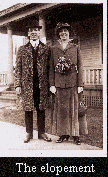 |
. |  HH Schulkers, Seck's dad, and my great-grandfather |